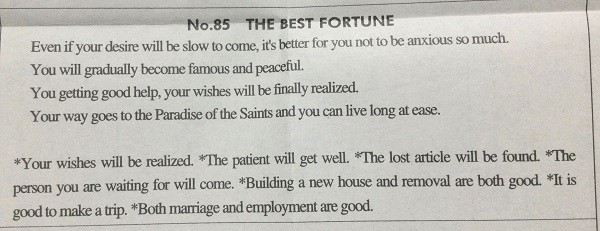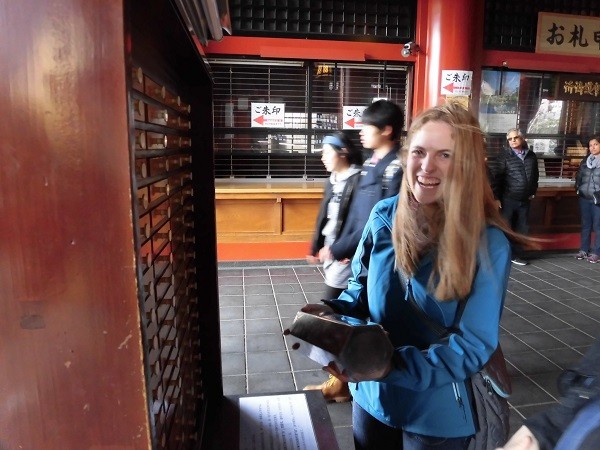Omikuji are fortune papers you find at Shinto shrines and Buddhist temples in Japan. Many people want to try this type of fortune telling when they visit these religious facilities. That is because Japanese people often go there when they need some mental support, and the paper may give them some useful advice. During New Year’s Day, when many people visit these places, the temples and shrines prepare additional omikuji places to give everyone a chance to find out their fortune for the new year.
Rituals to receive a message from deities have been held from a long time ago. And it is said the current fortune paper style started in the 10th century with a monk named Ryogen at the Ganzandaishido Temple in Hieizan, Kyoto.
What is Witten on the Paper?
Let us explain the different parts of an omikuji paper, so it will be easier for you to understand what you are reading.
Message from the Deities and Buddha: It may be written in the form of a poem in Japanese (or in Chinese at some temples). It is difficult to understand the meaning because the real message is often hidden behind the poem. But luckily the meaning is explained on the paper. Here is an English example from Sensoji Temple in Tokyo.

The Level of Your Fortune: The paper indicates the overall level of your fortune. Best fortune is the top followed by good fortune, small fortune, and bad fortune. Some facilities may have more categories, and some facilities may not have the bad fortune category at all. It is probably good to know that some temples and shrines actually have many papers with a bad fortune, so you don’t have to feel too bad about drawing one of them.
Your Fortune in Various Areas: The paper also indicates your fortune in different areas. For example, your wish, a person you are waiting for, a lost item, traveling, business, study, investment, competition, love, moving, childbirth, disease, and marriage.
Languages: Fortune papers are written in Japanese, but temples that get many foreign visitors may have omikuji in foreign languages such as English and Chinese.
How to Draw Omikuji?
It depends on the religious facility. At some facilities, there is a box containing a bunch of rolled papers. You put money into the offertory box and pick one of them. One omikuji normally costs 100 yen.
Many facilities also have the following system. You shake a box that contains many sticks, each stick bearing a number. Then you shake the box, draw one stick, and check the number. You take the paper from the drawer with the corresponding number.

Some facilities may even have an omikuji vending machine. When you put the money in, the paper will come out automatically.
What to Do After You Read Omikuji?
Different facilities may explain differently, but basically, if you draw a good fortune, you can take it with you as a good luck charm. But if you draw bad fortune, do not worry too much. There are bars or ropes to which you can tie your bad fortune paper. You can find them close to the omikuji drawing place.
It is prohibited to tie it on tree branches because it may damage the trees and it takes time for the monks or priests to take it away. Anyway, if you tie your paper to the provided bars or rope, you will be free from the bad fortune. It is recommended though to read the message before you tie it, as it may contain useful information.
Omikuji Trends
Love Omikuji: It especially indicates the fortune of your love life with a message from the deities or Buddha. It gives you your overall fortune level, too.
Omikuji with a Small Amulet: Some omikuji are more expensive than the normal paper one because they contain small omamori or good luck charms. It may be a small metal auspicious animal. For example, turtles and cranes are symbols of longevity and carps are a symbol of strength. This symbolism is also visible at other times in Japan. For example, you may find carp streamers around the Children’s Day holiday, hoping that children will healthy and grow strong. The frog is auspicious, too. It is called ‘kaeru’ in Japanese which means ‘to return’, so it is a symbol of the safe trip home or money that returns.
Your Japan Tour
As seasoned Japan experts, we can help you create your perfect Japan tour. We will include guides who can tell you all about omikuji and other religious customs in Japan. Contact us to start planning your unforgettable holiday to this fascinating country. Japan is full of once-in-a-lifetime experiences, culture, history, nature, and delicious food!